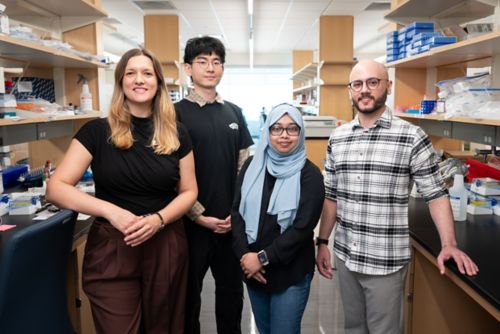St. Jude Family of Websites
Explore our cutting edge research, world-class patient care, career opportunities and more.
St. Jude Children's Research Hospital Home

- Fundraising
St. Jude Family of Websites
Explore our cutting edge research, world-class patient care, career opportunities and more.
St. Jude Children's Research Hospital Home

- Fundraising
Dolores Irala Lab
Investigating astrocyte-neuron communication during brain development and neurodevelopmental disorders.
About the Irala Lab
The development of functional neuronal circuits depends on the proper formation and function of neuron-neuron connections, known as synapses. The balance between excitatory and inhibitory synaptic contacts (E/I balance) is crucial for correct brain function, and disruption of this balance is a hallmark of numerous neurodevelopmental disorders. Astrocytes, star-shaped glial cells of the central nervous system, have emerged as key regulators of both excitatory and inhibitory synaptic contacts. In our lab, we investigate the cellular and molecular mechanisms of astrocyte-neuron communication during brain development in health and disease. Our research focuses on how astrocytes control synaptic diversity and synaptic balance, shaping brain connectivity during development.
Our research summary
Astrocytes are master regulators of synaptic diversity and balance. In the developing brain, the bulk of synaptogenesis occurs after astrocytes are born, and through cell adhesion molecules and secreted factors, they orchestrate a wide variety of synaptic contacts. Given the significant heterogeneity of inhibitory neurons and their synaptic contacts, a one-size-fits-all approach is not suitable. Therefore, our lab employs an integrative and multidisciplinary approach to investigate astrocyte-interneuron crosstalk, aiming to elucidate how disruptions in this interaction contribute to synaptic imbalance.

A missing key: Synaptic balance
In the last two decades, numerous astrocyte-secreted factors controlling excitatory (glutamatergic) neuron development and excitatory synaptogenesis have been identified. However, the identity of astrocyte-secreted factors controlling inhibitory (GABAergic) neuronal growth, maturation, and inhibitory synaptogenesis remains largely unknown. We recently identified that astrocytes specifically regulate somatostatin+ inhibitory synapse formation and function through secretion signals. Our results unveiled a novel mechanism through which astrocytes control circuit-specific inhibitory synapse development in the mammalian brain.

To continue exploring the role of astrocytes during inhibitory synaptogenesis and synaptic balance, we are now interested in dissecting the cellular and molecular mechanisms that astrocytes utilize to trigger different inhibitory synaptic contacts and neuronal growth. Our long-term goal is to elucidate how neuron-astrocyte communication shapes brain connectivity. Thus, by understanding the driving forces that rule brain development, we can design therapeutic approaches for neurodevelopmental disorders.
Our approach
The laboratory utilizes a wide variety of cellular and molecular techniques, including super-resolution microscopy, electron microscopy, cell culture, human brain organoids, and omics. And while our investigation is rooted in basic science—uncovering the cellular and molecular underpinnings of astrocyte-neuron communication in health and disease—our vision is to develop novel therapeutic strategies for neurological disorders.

Publications
Contact us
Dolores Irala, PhD
Cell and Molecular Biology
MS 326, Room M3417
St. Jude Children's Research Hospital

Memphis, TN, 38105-3678 USA GET DIRECTIONS